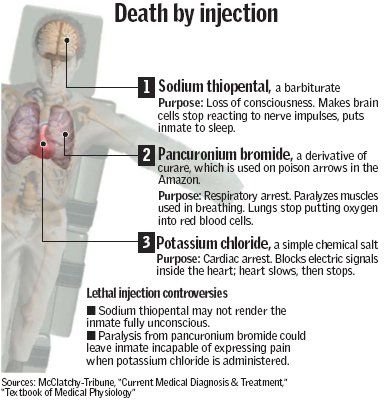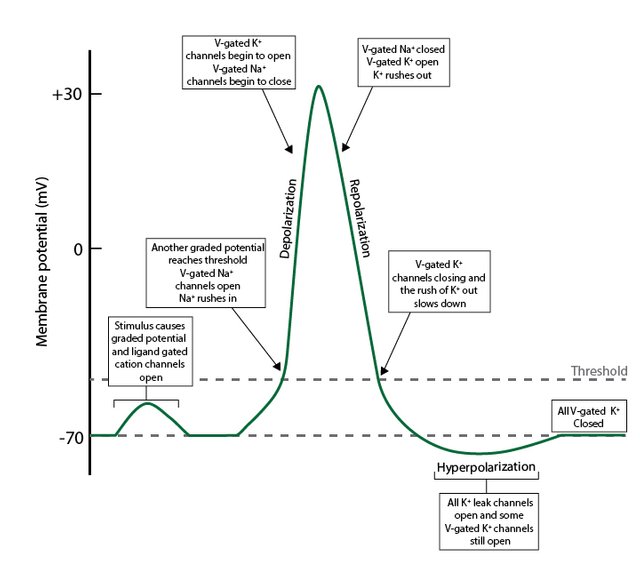Lethal Injection: The Science Behind the Deadly Solution
The ethicality of mortally reprimanding the murderous reprobate has long been debated. Some would adhere to the ancient Greek proverb, "Live by the sword, die by the sword". Others would lean towards, "Live and let live", or "Only God can decide life and death". I am writing this article with the intent of being completely unbiased about whether lethal injection is right or wrong. My focus will be on the scientific mechanism of action, and how exactly the lethal injection takes the life of condemned death-row inmates.
Overview
The lethal injection is actually a series of three shots into two intravenous lines, one in each arm. One of them is simply for back-up in case the primary line fails somehow. This takes place with the 'subject', if that term is an appropriate one, strapped down to an operating table by the arms and legs. Before any drug is administered, both lines start with an isotonic saline in order to check for bubbles or kinks. The first shot is meant to sedate the sentenced, and remove any sense of pain. It moves them into a dazed state, which causes the breathing to slow, and eventually causes a deep sleep, or unconsciousness. This first dug is usually sodium thiopentane, pentobarbital, or some other barbiturate. These are depressant drugs that result in a sense of relaxation and reduced anxiety before ultimately leading to unconsciousness by increasing the activity of gamma-Aminobutyric acid (GABA), an inhibitory neurotransmitter. I'll talk more about that later.
The second shot to be administered through the IV is a paralytic called Pancuronium Bromide. This drug causes paralysis of skeletal muscles by blocking the neuromuscular neurotransmitter Acetylcholine (Ach). This includes the diaphragm, the skeletal muscle that is the key mover of the lungs. Without function of the diaphragm, breathing stops completely and death would eventually result by asphyxiation without administration of the third, and more morbid compound, Potassium Chloride.
The Action Potential
In order to more fully understand how Potassium Chloride can disrupt every signal from the brain to the rest of the body, cause cardiac arrest, and ultimately death within ten minutes, we must first understand how the brain propagates these nerve impulses, or action potentials. Action potentials are threshold-triggered, all or nothing signals that transmit electrical impulses down nerve cell axons. When the signal reaches the axon terminal, a neurotransmitter will be released from synaptic vesicles therein and either propagate the signal onto another axon's dendrites, or the target tissue; either a muscle or gland.
Every nerve cell possesses a resting membrane potential. This means that there exists a difference in electrical charge between the intra- and extracellular spaces. The normal measure of this potential is generally around -70mV, with the inside of the cell being negative with respect to the outside. The negative here is not the mathematical sense, but negative in the sense of electrical charge. The cause of this difference in electrical potential is a balance of charged ions in and out of the cell. The resting membrane potential is maintained by the Na+/K+ ATPase pump. With each cycle of this transmembrane pump, two positive Potassium ions are pumped into the cell, and three positive Sodium ions are pumped out of the cell, resulting in a net negative charge inside the cell. This pump sets up two gradients, the net negative charge results in an electrical gradient, and the consistent pumping of each ion in and out of the cell respectively sets up a chemical gradient. Both gradients cause Sodium ions to be drawn to the inside of the cell, and the Potassium ions out. These are prevented from doing so by voltage gated ion channels.
When a nerve cell receives excitatory input, it depolarizes the cell. This means the potential moves from resting -70mV with respect to the inside, towards a more positive -55 to -40mV. This range of voltage is known as the threshold. If this threshold is reached, voltage gated Sodium channels open, and Sodium ions rush into the cell, down its electrical and chemical gradient. This influx of positive charge causes the voltage of the cell to reach a positive value of around 35mV. In turn, this causes voltage gated Potassium channels to open. And Potassium ions rush out of the cell, down its electrical and chemical gradient, bringing the voltage down below the resting membrane potential. this is called hyperpolarization. The resting membrane potential is restored by Sodium/Potassium ATPase pumps. Many action potentials are repeated along the axon over time until it reaches its target.
Potassium Chloride
When the third shot is administered, a flux of positive potassium ions floods the extracellular fluid. By adding these extra positively charged ions, both the chemical gradient and electrical gradient are disrupted. Potassium is no longer more concentrated inside the cell. And with a higher concentration of positive ions outside of the cell, it takes much more excitatory stimulation for the cell to reach threshold and fire an action potential. With the right dose, this change in membrane potential can be too great to overcome and threshold will be impossible to reach. With no action potential possible, death will occur. Inhibitory neurotransmitters like GABA work similarly. Both GABA, and alcohol bind to ligand-gated chloride channels, keeping them open. The negatively charged Chloride ions rush into the cell and hyperpolarize it, making it less likely for and action potential to occur; much like the concept of a double negative.
The action potential is how the brain communicates to the rest of the body. when this signal is blocked in such an extreme way as Potassium Chloride and the lethal injection, the result is just that... lethal.
Sources:
Kaplan. MCAT: Biology review. Kaplan Publishing, New York. 2016. Print.
Bushak, Lecia. The Science of Lethal Injection: How Most Capital Punishments Work. 2014. Retrieved from www.medicaldaily.com/sciene-lethal-injection-how-most-captial-punishments-work-311632%3famp=1
Kaplan. MCAT: Behavioral sciences review. Kaplan Publishing, New York. 2016. Print.
.
Image sources



Interesting, indeed!
Interesting topic of discussion. However, I assume you forgot to cite all of your images' sources. You might want to do that. Ensure that you have been using reusable images from the internet. Please refer here if you're not familiar with what I was talking about.
If you have any problem regarding STEM-related articles, you can join steemSTEM Discord Channel and we will be glad to assist you.
Very interesting!!! :)
Thanks for the continued guidance!
I understand what you mean about reusabke images now. Is it alright to site them at the end like I did? @chloroform
Hi, @nhahn93. That was not appropriate. If you would like some tips on how to make it right, you can refer to my previous article on this matter:
https://steemit.com/steemstem/@chloroform/if-you-re-planning-on-writing-an-article-for-steemstem-these-tips-are-for-you
You need to link the picture to the original website, not google search engine. By the way, I don't think all of your pictures were reusable.
Interesting this topic. Very good to debate. Regards
Thank you! Indeed!